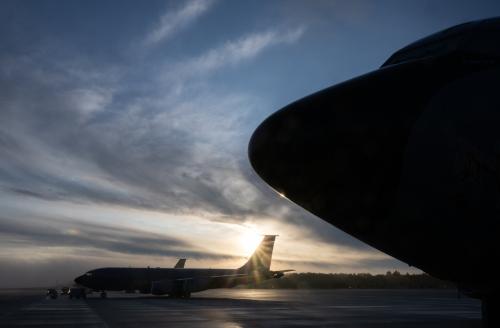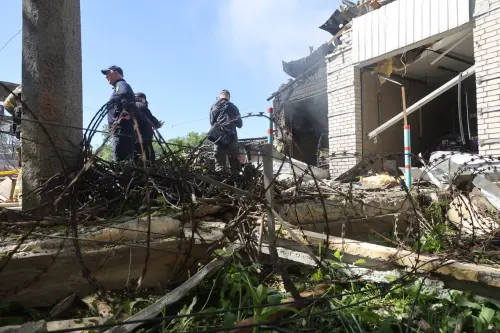The Obama administration has begun to spell out details of its new defense strategy and budget plan, which proposes to reduce military budgets by nearly $500 billion over 10 years, close to 10 percent of nonwar costs.
A key component is to halve U.S. combat brigades in Europe from four to two — keeping one each in Germany and Italy.
Part of the argument is economic. But it’s not that it saves a lot of money to bring forces home from Europe — perhaps only a few hundred million dollars a year. Rather, at a time of high U.S. unemployment, the administration may be calculating that the economic stimulus created by military bases should benefit local American communities rather than those in Germany or Italy.
The Obama administration, however, is not applying this logic in Asia. It remains unwisely committed to relocating up to half the U.S. Marines now in Okinawa, Japan, to Guam — and then building a new airbase in Okinawa for those who remain. (As this op-ed piece went to press, reports suggested that some modest changes in current plans were being considered.)
But a more fundamental rethinking is appropriate. Current plans will likely cost Washington, and the Japanese government, at least $15 billion each over the next decade. Most of this money could be saved — and provide a relatively painless contribution to the Pentagon’s daunting task of finding roughly half a trillion dollars in savings, as required by the Budget Control Act. There is a way to do it that won’t weaken U.S. power in the Pacific one iota.
The administration should simply downsize the Marines in Okinawa without building new facilities in Guam. Since the Marine Corps’ strength is apparently slated to decline by about 20,000 over the next few years — almost three times the number of Marines slated to be repositioned in Guam — it can remove those Marines from the force structure, perhaps by reducing the number of regiments in the 3rd Marine Expeditionary Force.
This would mean changing the composition, but not the overall size, of those Marine units that remain in Okinawa relative to current plans. Some additional Marines will wind up in Darwin, Australia, under the initiative announced this fall — but that will be a more modest increase.
This approach would likely reduce the pain felt stateside in communities near major Marine Corps bases. There would be fewer reductions than anticipated at Camp Pendleton in California, Camp Lejeune in North Carolina and facilities in Hawaii. They would still be necessary — but would not have to be as large as before. This way, major federal costs could be avoided and economic disruptions in three states minimized.
Guam would lose out a little under this plan, to be sure. But it is already enjoying a surge in Air Force and Navy presence and federal spending — so this change would merely slow growth rather than cause cutbacks.
Of course, the situation in Europe is far different from East Asia. U.S. troops in Europe are not needed to protect against anything like the Soviet threat of old. In addition, the Obama administration has made plain its frustration with some allies there who are not contributing enough to the collective defense effort pledged under NATO guidelines.
By contrast, in Asia, North Korea remains volatile as well as nuclear armed, and China is rising in historic fashion, reshaping regional power balances. It would be a poor time to signal any weakening of U.S. resolve there, as President Barack Obama, Defense Secretary Leon Panetta and Secretary of State Hillary Clinton wisely underscored on visits to key East Asian and Western Pacific countries last fall.
But there are less expensive ways to do it. Moving 8,000 Marines from Okinawa to Guam would be perhaps the most expensive troop redeployment, per capita, in U.S. military history.
If Japanese domestic politics and military practicalities force Washington to relocate many functions of the airbase in Okinawa and scale back troop numbers there, we can retain our capacity for rapid deployment to East Asian contingencies in other ways.
The best approach would focus on pre-positioning military supplies on ships in Japanese waters. Rather than deploy roughly 8,000 Marines to Guam — without enough nearby ships to transport them, anyway — the Marines could stay in Hawaii or California. But duplicate equipment could be stored on ships, based perhaps in Sasebo, Japan, where the Marines already have four amphibious ships.
If there were a crisis, say in North Korea, the Maritime Prepositioning Ships could sail to Korean waters, and Marines could fly from the U.S. to marry up with their equipment where they were needed. Calculations show that this approach would actually improve U.S. military responsiveness for most key contingencies in Asia — and at lower cost.
Japan likely could be persuaded to share in the costs of the extra equipment and ships, which would be less than $10 billion for the two nations combined, according to our estimates. And Washington would still have about 7,000 Marines in Okinawa, who could be deployed in smaller numbers for more limited challenges that might arise in the region.
Best of all, this new approach could well break the logjam in U.S.-Japan relations over the Okinawa airbase and Marine Corps relocation plan, which has now befuddled three U.S. presidents and roughly 10 Japanese prime ministers — including Yukio Hatoyama, who lost his job partly over this issue.
The world’s two richest democracies have wasted too much diplomatic energy on this issue for far too long. There is a better and cheaper way.



Commentary
Op-edRethinking Okinawa, Japan Military Relocation
February 4, 2012